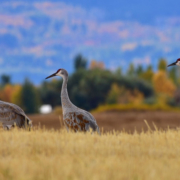Sandhill Cranes of the Greater Yellowstone
By Joselin Matkins, Executive Director, Teton Regional Land Trust
The Greater Yellowstone region is home to the largest intact ecosystem in the lower 48 states of the US. This means that residents and visitors alike have the opportunity to view wildlife regularly and experience all that nature has to offer, including observing iconic species such as the Greater Sandhill Crane, having walked our earth for over 10 million years.
Sandhill Cranes are one of 12 species of crane around the world. Because of their captivating song, expressive dances, and complex, human-like social behavior, cranes have captured our attention and reverence for centuries. Across the world, they are honored as signs of hope, resilience, and renewal and their annual migrations are celebrated with crane festivals, that include song, dance, and community gatherings.
Here in the Greater Yellowstone region, we are lucky to see cranes from March to October. Each year, thousands of Sandhills return to nest and raise their young. They are found across the region in a wide range of habitats that are closely connected to water and vegetative cover from predators. Sandhills pair for life and typically raise one to two young per year. Their young grow up to an inch a day!
As fall approaches, families of Sandhills (typically the parents and one or two young), seek out staging habitat so they can fuel up for the long migration to their wintering grounds in New Mexico, Arizona, and Mexico. What these Sandhills are looking for is a very unique alignment of resources that is found in abundance in Teton Valley, Idaho. They are seeking out shallow wetland areas, known as night roosts, where they gather in large numbers for safety and security. They spend the night in these areas, standing in shallow water so that they can hear approaching predators. Each morning at dawn, they go in search of the other aspect of this critical alignment, food. Surveys by the Teton Regional Land Trust since 2003 show that what Sandhills are looking for is cut grain leftover from harvest within no more than two miles of their night roosts. This proximity enables them to efficiently build up the resources they need to make the migration south. Presumably, they also prefer the cut grain for the same reason they prefer to spend the night in standing water – the ability to see predators approaching.
Because of the Teton River, its associated wetlands, and the agricultural productivity on the west side of the Teton River, the Teton Valley hosts the largest staging population of Sandhill Cranes in the Greater Yellowstone Ecosystem, with up to 2,000 cranes making their way from around the region to the Teton Valley to complete this critically important aspect of their lifecycle.
The Teton Regional Land Trust has long recognized the importance of protecting critical habitat and working lands in the area. For nearly 30 years, our focus has been to ensure that habitat and agricultural lands upon which our community and the wildlife rely upon are sustained. As development pressures continue to increase, the need to act to ensure the Greater Yellowstone remains the largest intact ecosystem in the lower 48 has come to a critical juncture, the time to join in this effort is now.
This is why the land trust began hosting the Greater Yellowstone Crane Festival in 2018. The purpose of the festival is to create a community-wide celebration of the Greater Yellowstone region’s exceptional wildlife and irreplaceable natural resources and the fall migration of the Sandhill Crane. Much like crane festivals around the world, we come together as a community to honor and respect the wildlife with which we share this special place. The Festival’s proceeds will support the efforts of the Greater Yellowstone Sandhill Crane Initiative which works to protect crucial habitat and resources for the largest staging population of Sandhill Cranes in the Greater Yellowstone and the myriad of iconic species that call the region home. By protecting the habitat that Sandhill Cranes rely on, we are also protecting habitat for the wide variety of species that call the region home.
I hope you will visit our website to learn about the week of activities planned and that you will join us for the community celebration in Driggs on Saturday, September 21. This family-friendly festival is filled with activities throughout the week including photography and art workshops, crane viewing tours, a keynote lecture from a renowned photographer, a film screening following a crane on its epic migration journey, and local art auction at the Teton Science School. The Festival will also host and an art exhibit and panel discussion at the Driggs City Center, exploring the intersection of art and conservation. The festival culminates with a day of natural resource education, a Teton Raptor Center exhibit, arts and crafts, live music, food and drinks, and stage performances including choreographed “crane” dances and poetry readings. I hope you will join us for this community event to celebrate and catalyze conservation of Sandhill Cranes and the Greater Yellowstone Ecosystem. We look forward to celebrating with you!



